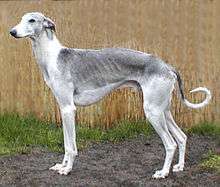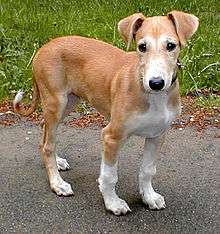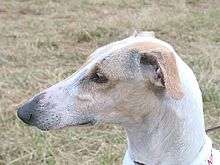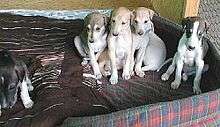Hortaya borzaya
 Adult male grey and white piebald hortaya borzaya | |
| Other names | Chort, Hort, Hrt, Chortaja borzaja, Xорт, Kурч, Kurtas |
|---|---|
| Common nicknames |
Chortaj Hortaya Horty |
| Origin | Ukraine, Grand Duchy of Lithuania, Polish–Lithuanian Commonwealth, Belarus, CIS, Russia |
| Breed status | Not recognized as a standardized breed by any major kennel club. |
| Notes | Nationally recognized by the FCI member clubs of all the individual CIS member countries, Czech Republic, Slovakia, Estonia, Latvia and Lithuania |
| Domestic dog (Canis lupus familiaris) | |
The hortaya borzaya (Russian: Хо́ртая Борза́я; IPA: [ˈxortəjə bɐrˈzajə], Ruthenian and Ukrainian: Xopт, Lithuanian: Kurtas, shorthaired sighthound) is an old Asian sighthound breed originating in the former Kievan Rus, later Grand Duchy of Lithuania (later Polish-Lithuanian Commonwealth) and Russian Empire. It is a dog of large size, of lean but at the same time robust build, of considerably elongated proportions. In its everyday life the hortaya is quiet and balanced. It has a piercing sight, capable of seeing a moving object at a very far distance. In spite of its calm temperament the dog has a very active reaction to running game. Hortaya are excellent, enduring hunting dogs endowed with a good, basic obedience and completely lacking aggression towards humans.
Description
Appearance
The hortaya is a sight hound of a large to very large size depending on breed type. The breed has five distinct types, with at least as many subtypes to each main type. The result of this is a broad variability, adapting the breed to the large variety of geography, climate and prey found across the huge expanse of its habitat.
All breed standards for hortaya are performance based, rather than appearance based, but because certain characteristics make for skilled hunting dogs, most hortaya are very similar in shape and build. The legs are long, the spine flexible, and the chest disproportionately deep in comparison to the waist, in order to accommodate large, powerful lungs. Small ears and a long, narrow skull are typical.
Hortaya males range from 26 to 30 inches (65 to 75 cm), females from 24 to 28 inches (61 to 71 cm). The weight depends largely on type and can range from 18 kilograms (Stavropol-type female) up to 35 kilograms (northern-type male). In general, the hortaya is heavier than it looks.
When not hunting, the typical gait of the breed is a fluid, limber and effortless trot. When chasing the prey, hortaya gallop in fast leaps of great length.
The short, dense fur can come in any color, as the only breed standards for the hortaya are health and skill. Dark coloured dogs typically have a black nose, while light coloured dogs typically have a brown nose. Eyes may be any color, and typically have a black or very dark rim.
Starting in the 2000s, some hortaya were exported to parts of Europe and North America (see below), where a breed standard for a new, as-yet unnamed subtype was established. Among these dogs, coat colour and colour combinations are restricted to a few types: white, black, cream of all shades, red, sable and brindle, solid or piebald (with white markings, or white with coloured markings). A black overlay and black mask, grey or red tan markings are normal. Atypical colours and markings, like brown or chocolate, a saddle or dapple pattern, and diluted colors (isabella) with blue or light eyes are not allowed. This subtype is still being defined, and further restrictions may be implemented, but it should be noted that the standard of the original hortaya remains unchanged.
Temperament
The hortaya borzaya is of a friendly, but distinctly Asian character. It is never aggressive or fierce towards humans, even though occasionally quite vigilant. Due the rigorous selection on hunting in a team with its owner, the hortaya belongs to the trainable sight hounds, showing a good basic obedience and high intelligence.
It is very close to wolves in its pack behaviour. Thus it is usually no problem to keep even larger groups of hortaya together in a kennel; hortaya integrate easily.
As rural people in Eurasia do not at all tolerate dogs which harm their livestock, properly socialized hortaya do not hunt domestic animals, and can easily be taught which animals are off limits to them.
Health

The breed is late in development, very vigorous and long-lived. It is not rare that older dogs, retired from active hunting, start their breeding career at an age of 8 or 9 years in perfect health and without any impairment. Breed-specific illnesses or hereditary diseases, such as hip dysplasia and elbow dysplasia, are so far unknown. The life expectancy of the hortaya borzaya largely depends on its use.In regions where they are hunted on large prey, especially predators, there may be quite some dogs killed young during the hunt. If you subtract these dangers, 14-15 healthy years as an average is not uncommon.
However, great care has to be taken in not over-feeding the hortaya pup and juvenile. The breed was formed on a meagre, extremely basic and low diet with but rare and small amounts of meat, especially high quality meat.
Most of the year hortaya get little more than the scraps from the table, a gruel of oats, bread soaked in milk and whatever rodents they can hunt for themselves around the house. Only during the spring slaughter/lambing season and the main hunting season they get more meat: the innards and offals from what they hunt for their masters. As a result, this breed has practically no tolerance for high quality, high protein dog foods and supplements, and especially the young, still growing dogs will suffer irreversible and lethal damage to their bone structure and cartilage when faultily fed.
Use and activity
In its original habitat, the hortaya borzaya is still purely a hunting sight hound. It is used on all game living in the steppe, especially for hunting hares, foxes, wolves and Saiga antelopes. It is extremely enduring, capable of working from early morning to late evening. Up to 8–10 runs on game in a day (including tracking prey together with the hunter across large distances) is a perfectly feasible workload. Unlike the Whippet or Greyhound, the hortaya is not a short distance sprinter. Game is usually chased for distances up to 4 km (2.5 mi) on the open steppe, and a hortaya can repeat such runs after only a short rest. Unlike most sight hounds, the hortaya does not hunt using sight alone; it often will track game it has lost sight of using its well-developed sense of smell.

Hortaya hunt singly on smaller game, or as pairs and larger groups on wolves, antelopes and deer. Small game is hunted and killed immediately, larger game is cornered and held in place for the hunter. The hortaya has a "soft mouth" like the Retriever breeds. After a quick kill, the game must not be rent as native hunters also use the furs. In the CIS hunting sight hounds are regularly tested, judged and graded in so-called "hunt trials".
The first hortaya have recently been officially exported with full breeding papers to European countries, e.g. Czech Republic, Slovakia, Germany (2004), Finland and Switzerland. In 2005, the first hortaya was also exported to the United States. Some of these dogs participate in racing and coursing, partly out of competition due to the lack of international FCI recognition. Hortaya owned by European owners have shown an aptitude for Agility, Breitensport and have proven to be excellent trail companions for horseback riders. The first registered litter outside of the hortaya's historical habitat was born in Europe in 2006.
Breeding

Contrary to the practice of Western breeding and breeders of other dog breeds, the hortaya is not regarded as an unfinished breed which still needs any amelioration or even formation.
The shorthaired sightdog of the southern Eurasian steppes, which today trades under the name of hortaya borzaya, was bred in this habitat for thousands of years, is a breed as old as the Tazi/Saluki and only marginally younger than the Bakhmul/Afghan. For newcomers it would be unwise to be deceived by the relatively recent standard.
Analogous to the oriental and Asian breeds of thoroughbred horses the original breeders of hortaya consider it rightfully as firmly consolidated. An improvement into any direction therefore is not part of breeding hortaya. This is an important and massive difference to the western way of dog breeding and it has far reaching, very positive consequences for the breeding practice.
As no changes are striven for the breeding methods used among other breeds to achieve them, like incest, inbreeding or linebreeding, are practically non-existent. These methods are seriously frowned upon among hortaya breeders. It is extremely rare that ancestors appear twice among the first 4-6 generations of a pedigree. In fact, hortaya breeders try hard to achieve the farthest possible outcross. This is one important reason why the breed is so healthy in spite of its relatively small population.
Another consequence is the application of the breed standard. It does not describe any "ideal dog" which should be bred for, as it is with other dog breeds. Instead the hortaya standard is a standard of exclusion: it only and very simply describes the boundaries outside of which a dog would not be considered acceptable. Anything else would be pointless, as it is the active endeavour of hortaya breeders to preserve the large variety of types and sub-types of the breed, which may seem being totally different breeds to the layman.
Additionally, with the hortaya it is its hunting ability which is the measure of everything, anything else is quite secondary regarding selection.
Looking at all this it also becomes clear, why an international acceptance of this breed by the FCI is not regarded as being very desirable by the majority of hortaya aficionados. The breed's breeding practice, its consolidated state and its truly extreme phenotypical diversity do not really fit into the actual breeding and judging practices of today's FCI or of any other major kynological federation. Any international FCI acceptance which would not result in immediate harm to the breed needs major, important groundwork and decades of preparation. Currently the direct and immediate consequence would be the undesirable separation into show and work lines, and into western and original hortaya.
History
The hortaya is an Asian dog breed, which developed over the centuries in the steppes north of the Black Sea, after spreading slowly from the mountains of Afghanistan westwards. Dogs of this type were bred by various peoples of this region, which extends from modern Ukraine and the south of Russia to the westernmost regions of Kazakhstan. Therefore, it is not possible to attribute this breed to a specific people or country. In the east and southeast of its geographical spread it connects to the oriental rsp. Central Asian sight hounds, while it is considered the link to the western sight hound breeds close to the Polish frontiers.
In the year 1951, the USSR laid down the first standard for the breed. Nowadays the Russian Kynological Federation (RKF), the national Russian FCI member association, officially maintains the standard. Currently there exist an estimated 2500-3500 hortaya borzaya worldwide, with less than a few dozen outside of the boundaries of the CIS.
An international recognition by the FCI does not exist so far, however the breed is nationally recognized by all FCI member countries within the CIS and by many other middle European nations. In some of these states the studbook is maintained directly by the national member organisation of the FCI, in others the hortaya is registered by specialized hunting dog associations.
The owners of these dogs are mostly local hunters, who live in remote, often isolated villages in the steppe. Few of them have any interest in shows. For them the hortaya is a valued co-worker who puts food on the table in winter. In the steppe a good hunting hortaya can be worth as much as a good riding horse.
The hortaya borzaya belongs to the extremely rare sight hound breeds, which - up to our modern times - has been selected exclusively on its hunting abilities and qualities.
References
- MVDr Marika Stanovoi, Prag, On the Breed Standard
- Biologist & breed judge Lada Ponomareva, Kursk, diverse articles
- Dr. Shubina, Moscow, diverse articles
- Tariel Gabidzashvili, Moscow, diverse articles
- Jan Eduard Chortaj - http://chortaj.nigilist.ru
External links
- Chortaj.com, an international website about the hortaya borzaya (English, German, Russian)]